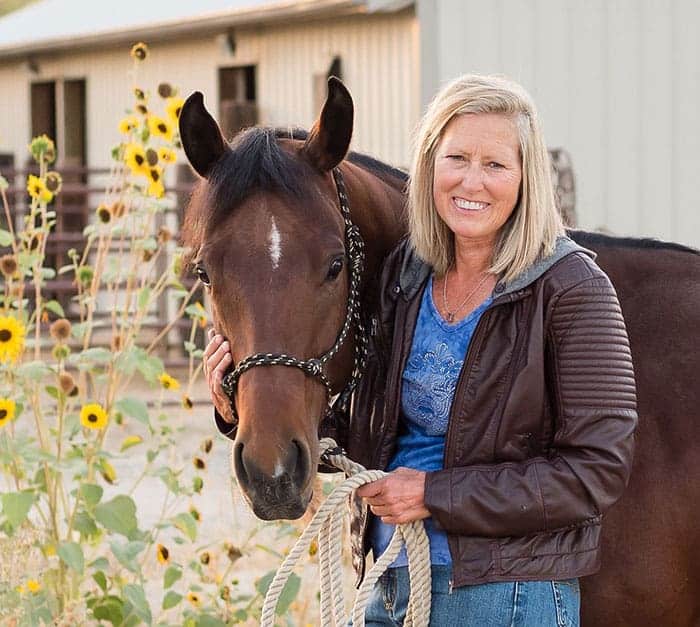Firewise Tips for Horse Owners
- Posted by Alayne Blickle
Here are a few points to help you identify wildfire risks for your horse property along with the appropriate actions to minimize those risks.
Share
ADVERTISEMENT

Clean roof surfaces and gutters to remove leaves, branches, or debris which can catch a stray spark from a nearby fire and ignite. | Photo: Alayne Blickle/Horses for Clean Water
Many horse owners live in rural areas that are surrounded by trees or open rangeland with grass or shrubs. In a dry year these materials can easily become fuels for wildfire–high temperatures, limited summer rainfall, strong winds, and lightning storms all lead to very high risk of fire danger.
Here are a few points to help you identify wildfire risks for your horse property along with the appropriate actions to minimize those risks. Follow up by reading the Smart Horse Keeping blog on developing a firewise evacuation plan, to help you put together an evacuation plan for your property and horses should the threat of wildfire become real.
- Create a defensible space between buildings that are less than 15 feet apart. A defensible space is an area where combustibles and vegetation is kept to a minimum. When planning or building new outbuildings place them as far apart as is reasonably possible, 30 feet or more is best.
- When possible, locate barns, shelters, and other structures on flat land or towards the bottom of a slope. Fires burn more rapidly up hills and draws than across a flat. Draws can serve as a chimney, creating more intense fires that spread rapidly with uphill drafts.
- Create a firewise landscape around your home, barn and other structures using plants that are low growing, drought tolerant, high moisture content, high salt or soap content, low oil or resin content, and have green stems. See the past Smart Horse Keeping blog on this topic.
- Flammable outdoor items can catch an ember and ignite. Remove things such as wood patio furniture, brooms, flowerboxes, and flammable doormats. Replace with nonflammable materials such as wrought iron patio furniture.
- Wooden or plastic fences burn and can lead a fire to buildings. Choose other types of fencing when possible. It’s especially important to avoid combustible fencing when it attaches to buildings or structures. If you already have this create a removable section such as a gate or panel that can be taken out or left open when there’s a threat of fire.
- When building or planning new outbuildings choose nonflammable materials such as metals for sidings and roofs. Consider tile, brick or adobe–and green roofs. Replace combustible sidings or roofs with nonflammables.
- Create a firebreak, a 15 to 30 foot buffer of cleared land placed between combustibles like crops, hay storage, bedding storage or feed storage, and other structures (barn, house, fences, etc.) A firebreak can be a plowed or disked strip, a dirt road, a path mowed down low, or possibly even a walking trail.
- Remove cheatgrass and dried weeds through grazing, mowing, prescribed burning or herbicide use. During fire seasons keep all vegetation within 100 feet of buildings either green and low or grazed down.
- Clean roof surfaces and gutters to remove leaves, branches or debris. These materials can catch a stray spark from a nearby fire and ignite.
- Keep firewood, trash, lumber, empty feed sacks 15 to 30 feet away from buildings or other combustibles.
Stay safe!
Alayne
Share

Written by:
Alayne Blickle
Alayne Blickle, a lifelong equestrian and ranch riding competitor, is the creator/director of Horses for Clean Water, an award-winning, internationally acclaimed environmental education program for horse owners. Well-known for her enthusiastic, down-to-earth approach, Blickle is an educator and photojournalist who has worked with horse and livestock owners since 1990 teaching manure composting, pasture management, mud and dust control, water conservation, chemical use reduction, firewise, and wildlife enhancement. She teaches and travels North America and writes for horse publications. Blickle and her husband raise and train their mustangs and quarter horses at their eco-sensitive guest ranch, Sweet Pepper Ranch, in sunny Nampa, Idaho.
Related Articles
Stay on top of the most recent Horse Health news with













5 Responses
re: Firewise Tips for Horse Owners
When a fire was approaching our back fence through neighboring woods, I was thankful to have a series of large gates that allowed the fire fighters and their equipment to get to the back of our property. Thankfully the wind died down just as the fire r
re: Firewise Tips for Horse Owners
Make sure to keep shoddy equipment that could cause fire out of the barn. Years ago I walked into a barn where I was working and the tractor was burnning in the aisleway. The previous stallcleaner had done his share of the stalls and left the tractor t
re: Firewise Tips for Horse Owners
I live just a little more than 40 miles south of Yarnell, Arizona, location of the deadly Yarnell Hill fire that claimed the lives of 19 firefighters. This particular blaze blew up from less than 100 acres on Sunday morning to over 2,000 on Sunda
re: Firewise Tips for Horse Owners
Some really good tips here! It’s amazing to think how many potential fire hazards there are, but some of these tips go beyond being firewise, such as cleaning gutters and weeding: it’s a good idea to do them regardless.
re: Firewise Tips for Horse Owners
Good BLOG post Alayne! I wanted to point our readers to a little more information on this topic at my 2012 blog about WILDFIRE SHELTER IN PLACE planning… at Good BLOG post Alayne! I wanted to “